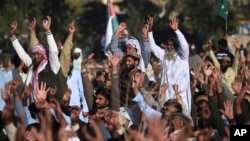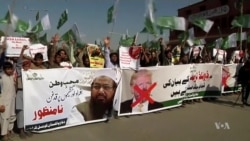The United States and Pakistan have had a relationship since its creation in 1947. While ties have been strained on numerous occasions, military and economic needs have dictated that the two nations remain cautious allies.
1947: Pakistan is established when colonial power Britain grants independence to India's mostly-Muslim northwest. The United States is one of the first nations to establish relations with the new sovereign state.
1954: Pakistan, torn between rival powers, chooses to ally with the United States instead of the Soviet Union. It signs the Mutual Defense Assistance Agreement with the U.S., which allows Pakistani soldiers to train in the United States in exchange for allowing the U.S. to set up a Military Assistance Advisory Group in Rawalpindi.
1956: Pakistan grants the U.S. Army permission to lease Peshawar Air Station, giving U.S. troops a base from which to monitor the Soviets' ballistic missile program. When a U.S. spy plane was shot down by the Soviet Union in its air space in 1960, Pakistan says it was deceived by the United States about the use of the base. Pakistan's relations with the Soviet Union deteriorate.
1962: U.S. President John F. Kennedy offers India economic and military aid during the Indo-China war, irritating Pakistan's President Mohammad Ayub Khan.
1965: U.S. suspends military assistance to both India and Pakistan during Indo-Pakistan war.
1970: Pakistan helps U.S. open communications with China, leading to the first U.S. presidential visit to China the following year.
1971: The U.S. suspends military aid to Pakistan over the civil war between East and West Pakistan. The war results in the formation of Bangladesh.
1975: U.S. resumes military aid to Pakistan, despite tensions over Indian/Pakistani nuclear rivalry.
1979: Under U.S. President Jimmy Carter, the U.S. again cuts off Pakistan's military aid, this time over its nuclear weapons activity.
Late 1979-1980: Soviet Union invades neighboring Afghanistan, leading to a U.S. promise of $3.2 billion in U.S. aid to Pakistan over five years. Pakistan becomes a route for arms and supplies sent by the U.S. to the Afghan resistance.
1990: Two years after the Soviets withdraw from Afghanistan, U.S. President George H.W. Bush responds to a new U.S. law preventing U.S. aid to Pakistan while it possesses a nuclear weapon. Military funds are cut and deliveries of major military equipment are suspended, including 71 F-16 fighters Pakistan had ordered.
1998: India and Pakistan both conduct nuclear tests and declare themselves nuclear states. The United States imposes sanctions restricting military sales, economic assistance, and loans to the Pakistani government. It also agrees to pay Pakistan a settlement over its refusal to deliver the F-16s.
2001: After the 9/11 attacks, Pakistan became an important ally in the U.S. fight against al Qaida and the Taliban in neighboring Afghanistan. The U.S. lifts some sanctions imposed on Pakistan after its nuclear tests in 1998.
2003: The United States forgives $1 billion in loans to Pakistan in thanks for its cooperation in the war on terror.
2005: Earthquake kills tens of thousands of people in Pakistani-administered Kashmir; the U.S. authorizes $510 million for relief, reconstruction, and humanitarian aid.
2009: Pakistan President Pervez Musharraf confesses that billions of dollars in U.S. aid to Pakistan were used to shore up Pakistan's defenses against nuclear rival India.
2010: U.S. intelligence agencies team with Pakistani forces to capture high-profile Taliban commander Mullah Abdul Ghani Baradar.
2011: U.S. Navy SEALS kill terrorist leader Osama bin Laden at his family compound in Abbottabad, Pakistan. There are conflicting accounts on whether Pakistani authorities were alerted to the operation before it took place.
2012: Shakil Afridi, a Pakistani doctor who cooperated with the U.S. on the Abbottabad operation, is convicted of treason in Pakistan and sentenced to 33 years in prison. In a pointed response, the U.S. Congress votes to cut Pakistani aid by $33 million, $1 million for every year of Afridi's sentence.
2014: The United States turns over Pakistani Taliban member Latif Mehsud to Pakistan as U.S. troops prepare to end their Afghanistan combat mission. Also in 2014, the U.S. uses drone missions to kill several of Pakistan's most wanted militants in the lawless region along the border with Afghanistan.
January 2, 2018: The United States announces it will continue withholding $255 million in aid from Pakistan over what the Trump administration describes as a failure to sufficiently fight terrorism.
WATCH: U.S.- Pakistan relations












